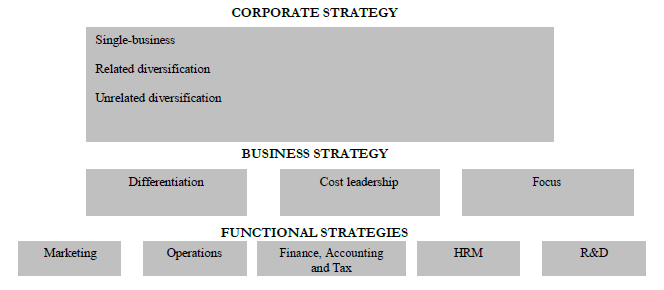
Corporate strategy
Corporate strategy helps a firm define the domain of business in which it intends to operate. A firm might adopt any of three forms of corporate strategy: single business, related diversification, or unrelated diversification;
The single-business strategy
A firm that adopts this strategy relies on a single business, product, or service for all its revenue. Advantage: concentration on one product or service. Disadvantage: vulnerable to changes in the external environment.
Related diversification
Most commonly adopted corporate strategy. A firm that adopts this strategy operates in several different but related businesses, industries, or markets at the same time. Advantages: less vulnerable, economies of scale and scope, wider use of its technology or expertise. Disadvantages: the cost of coordinating the operations of the related divisions, all business units subject to be affected by external forces.
Unrelated diversification
A firm following this strategy operates in several unrelated industries and markets. Advantages: risk spreading, easy to divest unprofitable operations and acquire new Corporate strategy
Corporate strategy helps a firm define the domain of business in which it intends to operate. A firm might adopt any of three forms of corporate strategy: single business, related diversification, or unrelated diversification;
The single-business strategy
A firm that adopts this strategy relies on a single business, product, or service for all its revenue. Advantage: concentration on one product or service. Disadvantage: vulnerable to changes in the external environment.
Related diversification
Most commonly adopted corporate strategy. A firm that adopts this strategy operates in several different but related businesses, industries, or markets at the same time. Advantages: less vulnerable, economies of scale and scope, wider use of its technology or expertise. Disadvantages: the cost of coordinating the operations of the related divisions, all business units subject to be affected by external forces.
Unrelated diversification
A firm following this strategy operates in several unrelated industries and markets. Advantages: risk spreading, easy to divest unprofitable operations and acquire new operations. Disadvantages: no synergy across business units, executives must be familiar with a much wider array of businesses and markets than if operations are related.
Business strategy
Business strategy focuses on each line of business within an organization and answers the question, “How should we compete in each market we have chosen to enter?” Firms that follow a diversification strategy (either related or unrelated) usually group lines of business into strategic business units (SBUs). A firm may develop a unique strategy for each of its SBUs, or it may follow the same strategy for all of them. The three basic forms of business strategy are differentiation, overall cost leadership, and focus.
Differentiation
Differentiation strategy is the most common form of strategy. A firm attempts to establish and maintain the image that the SBU’s products or services are fundamentally unique from other products or services in the same market segment.
Overall cost leadership
An overall cost leadership strategy focuses on achieving highly efficient operating procedures so that the firm’s costs are lower that its competitors. A firm then attempts to sell products in high volumes at low prices. (economies of scale)
Focus
A focus strategy calls for a firm to target specific types of products for certain customer groups or regions. Firms match the specific product features to the needs of specific consumer groups.
Functional strategies
Functional strategy answers the question, “How will we manage the functions of finance, marketing, operations, human resources, and research and development in ways consistent without international corporate and business strategies?”
Characteristics of Strategic Management Decisions at each Level
The characteristics of strategic management decisions vary with the level of strategy activity considered
Decisions at the corporate level
- are more value oriented, more conceptual, and less concrete that decisions at other levels
- characterized by greater risk, cost and profit potential
- include the choice of business, dividend policies, and priorities for growth
Decisions at the functional level
- implement the overall strategy formulated at the corporate and business levels
- involve action-oriented operational issues and are relatively short range, low risk but more concrete and quantifiable
- include decisions on Basic vs. Applied Research and Development, high vs. Low inventory levels, general-purpose vs. specific purpose production equipment.
Decisions at the business level
- Help bridge decisions at the corporate and functional level
- Are less costly, risky and potentially profitable than corporate level decisions, but more costly, risky and potentially profitable than functional level decisions.
- Include decisions on plant location, marketing segmentation and geographic coverage, and distribution channels.
Kavungya answered the question on
April 29, 2021 at 10:27